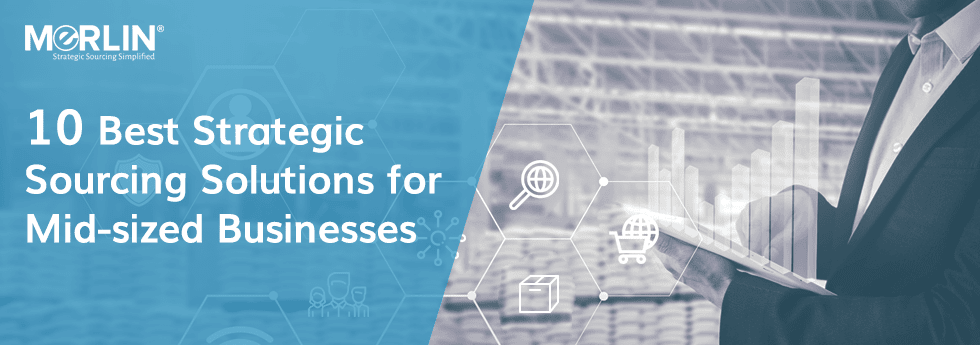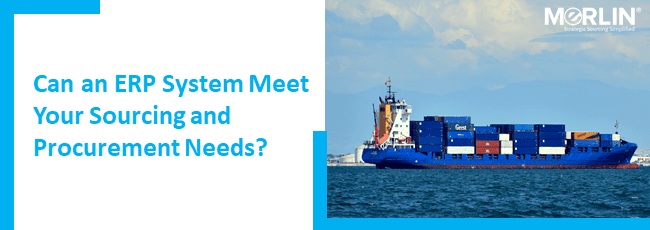
Strategic Sourcing Software to Deliver Value and Elevate Business Performance [Infographic]
Attain business excellence with strategic sourcing software – revolutionize cost optimization, supplier relationships and decision-making for savings.
Solutions
Create, Manage and Map Categories
Analytics, Reports, Dashboards, Cubes and much more
Register, Onboard and Manage Suppliers
Achieve LkSG compliance with MeRLIN
Never miss a critical contractual milestone
Streamline P2P processes with Workflows, Awards, POs, Supply Management & Receiving
Manage the Complete Lifecycle from RFx to Sourcing
Enable Sourcing Strategy Execution by Creating, Managing and Reviewing Projects with Multiple Stakeholders
Use Cases
Engineering Collaboration, PLM, ERP Integration, Demand Consolidation
Deep Dive into Spend Patterns for Greater Savings
End to End Solution for R & D establishments
Complete Lifecycle Management of Contracts - Creation, Authoring, E-Signature and Contract Milestones
Comprehensive Source to Procure Solution
Analyse Cost, Spend, Suppliers etc. Create Custom Reports & Dashboards
Analyse Cost, Spend, Suppliers etc. Create Custom Reports & Dashboards
Drive Cost Savings & User Adoption
MeRLIN’s Strategic Sourcing Solution is an all in one platform for Direct and Indirect Procurement to standardize and streamline your business processes.
Consolidate Demand, get Visibility of Volumes
Define, Execute and Manage your Sourcing Strategies with ease
Compare side-by-side, negotiate and Select Suppliers
Simplify Price Discovery and Item Search with Catalogue Management

MeRLIN’s Strategic Sourcing Solution provides the features you need to create the right strategic environment to arrive at supplier agreements that deliver the best sourcing results and sustainable savings.







Attain business excellence with strategic sourcing software – revolutionize cost optimization, supplier relationships and decision-making for savings.

Discover alternative strategic sourcing solutions for mid-market businesses and make tailored selections based on specific needs, budget and scalability.

Learn how a specialized sourcing solution beats ERP procurement modules in cost savings, supplier management, analytics and more.
The primary difference between procurement and strategic sourcing is that, while in traditional sourcing or procurement, the focus is primarily on the cost per unit, strategic sourcing evaluates the best possible value and Total Cost of Ownership with a view to optimizing the supply process by developing long-term, mutually beneficial partnerships with suppliers. In essence, it factors in three principal components – organizations spend profile, market circumstances, and suppliers.
An e-procurement software is only a platform to automate the procurement processes and does not have features to take care of the upstream activities in procurement like strategic sourcing, spend analysis, category management, contract management, etc. it just takes care of the transactional aspects of procurement like product catalog maintenance, raising purchase requests, Purchase Order (PO) generation, invoicing suppliers, receiving payments, etc.
Whereas a strategic sourcing solution helps with strategic sourcing management by standardizing sourcing requirements and providing a platform for gathering information about suppliers, products, markets, and business requirements. There are four key functional components in a strategic sourcing solution:
1. eSourcing/Strategic sourcing – A system for identifying buying requirements across the organization by consolidating demands from various systems like PLM, MRP, ERP, etc or buyer requisitions, r developing RFXs – RFIs, RFQs, or RFPs, requesting supplier proposals, and evaluating the bids received.
2. Spend analysis – Helps organizations to categorize spend data for enhanced spend visibility and do an in-depth analysis of the data. It helps businesses to quantify spend by supplier, category, parts, etc to identify opportunities for costs reduction and supply base optimization.
3. Contract Management – Enables organizations to document, track and manage their supplier contracts.
4. Supply Relationship Management (SRM) – SRM helps organizations to solicit and manage supplier information, monitor their performance, and manage supply risks.
Strategic Sourcing involves a systematic approach to sourcing by gathering and evaluating information about an organization’s buying requirements (total demand) combined with information about suppliers’ marketplaces as well as individual vendor performance. Unlike in traditional sourcing, the main emphasis in strategic sourcing is on reducing the Total Cost of Ownership (TCO) instead of focusing efforts on purchasing price per item. The strategic sourcing process includes 7 key steps to develop an effective sourcing strategy:
Step 1- Defining the category:
It involves identifying the spend areas across the organization and categorizing them. Also, the pre-requisites about the users, their locations, current quantity available, supply chain logistics are collected.
Step 2- Gather information about the supply market:
Finding the prospective global and local suppliers by analyzing their revenue, market share, etc along with risk analysis.
Step 3- Design the sourcing strategy:
This stage decides from where all the purchasing will be performed keeping in mind the risks and costs associated with it.
Step 4- Finalizing a sourcing process:
Deciding on the sourcing process to be used – RFI, RFP, RFQ, or eAuction
Step 5- Choosing a vendor and negotiating terms:
Selecting a supplier involves many rounds of negotiations with short-listed potential suppliers before finalizing the supplier.
Step 6- Implementation and integration:
Successful vendors should be notified and included in the implementation process.
Step 7- Analyzing results and benchmarking:
The last stage marks the commencement of a continuous cycle that begins with benchmarking the present condition of the commodity or category, monitoring the results, and ensuring that full value is realized.
A strategic sourcing software helps deployment of industry best practices in sourcing besides enabling greater levels of automation of your sourcing activities and helps simplify complexities of strategic sourcing. The major benefits of a strategic sourcing software include
– Increased visibility to sourcing processes and spend data
– Better supply risk management
– Shorter sourcing cycles due to extensive automation
– An enhanced collaboration with suppliers as well as internal stakeholders
– Better supply base optimization
– Higher levels of compliance and
– Enhanced reporting/analysis for better decision-making
Strategic sourcing is critical to a company’s cost structure and competitiveness. It also assists in improving the value-to-price ratio by decreasing costs and increasing the service quality on a continual basis. Strategic sourcing helps an organization by:
Efficient cost management and savings:
Both buyers and suppliers can gain from strategic sourcing. For purchasers, it’s advantageous since selecting suppliers that will provide the highest value at the right pricing, lowers the overall costs or cost of goods sold, allowing them to keep their product pricing competitive. For suppliers, the capacity to sell a large portion of their produce facilitates planning and management of long-term cash flow visibility. The strategic sourcing process also aids in vendor consolidation, which can expedite the procurement process and result in significant cost savings.
Adding supply stability:
It helps in developing stable supply partnerships to ensure supply chain stability and ensures that the needs of the organization are laid out well ahead of time. Suppliers and buyers can work together to measure defect rates and determine the root cause of defects.
Stronger Supplier Relationships:
Increased communication with suppliers helps businesses to build healthy and sustaining relationships with their suppliers and make them strategic partners. Strong relationships can result in faster lead times, more reliability and flexibility for the fulfillment, and assurance on material quality.
Risk Management:
Close supplier connections and continuous monitoring of supplier performance may assist businesses in identifying risks and resolving possible problems in a timely way.
RFI: “Request for Information” is a preliminary document utilized by firms who don’t know the market they’re intending to join. Thus, RFI is more of a fact-finding document where the organizations can ask open-ended questions that allow the vendor to discuss its whole range of products. Typically, the RFI would outline the broad business issues you are facing, and the vendor will adapt its answer to those challenges. To summarize, an RFI is issued when you are looking for information or you are not really sure what solution you need and an RFI response is intended to educate you on how a vendor can solve your problem.
RFQ: The RFQ, or “request for quotation,” is a more thorough document that dives down to the company’s particular demands and asks for suppliers’ pricing on the requested products or services. An RFQ is issued when you know exactly what you want and need to explore the cost to meet the request.
RFP: An RFP, or “Request for Proposal,” is a request for a comprehensive overview of suppliers’ companies and their background, detailed descriptions of the requested products or services. An RFP is usually sent when the requirement is more complicated and you want to evaluate other factors besides price to make a decision. Often times an RFP has a specific questionnaire required for submission. RFPs are considerably more detailed in terms of what a firm requires, defining the project’s business goals and providing specific requirements that are required for the request being served. An RFP response provides a clear picture of vendor offers and capabilities.
An e-auction or an electronic auction is a procedure in which a firm looking for some goods or services issues request for bids and providers can then submit their best price proposals online. The procedure starts with a brief survey to collect essential information from suppliers. Once the buyer has compiled a shortlist of suppliers, they may select a day and time for the auction and make it live. Suppliers will be able to bid against one another during the e-auction until the lowest offer is made. eAuctions allow businesses to reduce costs and time required for supplier quote negotiations.
An eAuction is to be used when the chances of industry competition are very high and there are many suppliers providing the product or service. eAuctions are most suited for high-volume purchases. It is an ideal option if the supplier relationship need not be strategic and the supply lead time is very less. It is mostly utilized for negotiated and limited public procurement procedures, as well as by multiple buyers consolidating their requirements.
Uncover meaningful insights from your sourcing data and trends that translates to new opportunities for savings and growth.

Error: Contact form not found.

Vetri celebrated three years as CEO of MeRLIN Sourcing in June 2023. His vision spearheaded the transformation of the company internally through modernization and HR transformation and externally with the promise of delivering value to customers and putting them at the heart of the MeRLIN Sourcing business and product development strategy.
Vetri built his career in global software businesses over the last decades. Seasoned professional with a global perspective, spanning the Americas, Europe, and Asia, and a diverse industry background across EPC, Defense, manufacturing, automotive, and life sciences industries.
A firm believer in the principles of doing well by doing good, he won his two awards as the IT Executive of 2014-2015 and 2016-2017 in Europe. He is a highly regarded global thought leader in the IT and cloud software industries and is an active investor/advisor for emerging companies. He is known as a leader who builds and motivates world class teams, champions diversity, and exudes a deep passion for how technology can transform the workplace and empower individuals.

Dr. Werner Breuers completed his studies in chemistry at the RWTH Aachen University with a doctorate. He began his professional career in 1989 as a chemist at Hoechst AG in Frankfurt in the research and development department.
After managerial positions at Hoechst AG, Dr. Breuers took over management of the license and catalyst business at the polyethylene manufacturer Elenac GmbH in Kehl in 1999, which became part of the Basell group a year later. As a member of Basell’s Executive management team, he headed the global Technology Business division based in Milan and most recently served as President of Basell Polyolefins Europe based in Amsterdam.
Dr. Breuers has also been a member of the Board of Management of LANXESS AG since May 14, 2007 and was responsible for the Performance Polymers and Advanced Intermediates business units. His responsibilities and strategic operations also include the functional areas of Global Procurement & Logistics, Innovation & Technology and Industrial & Environmental Affairs. He has been board of several other companies and has also served as trustee of RWTH Aachen University and currently advising and supportinfg the growth of MeRLIN Sourcing in Europe.

Oliver Scheffert is an experienced entrepreneur with a successful completed doctoral program in business administration and a master’s degree in International Business Studies. He held management positions at Microsoft for nearly 13 years, receiving prestigious awards for exceptional leadership and results like the Circle of Excellence Platinum Award. Notably, Oliver led the ISV business unit in Germany to a billion-dollar revenue stream.
He later served as the General Manager/Managing Director at Aparavi Software Europe GmbH and recently founded CNSLT Partners GmbH, a strategy and management consultancy, leveraging his extensive specialist knowledge to help IT companies achieve lasting success.